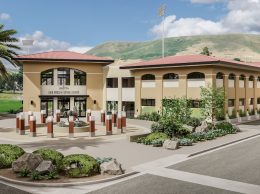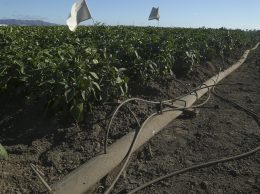Cal Poly professors tackle agricultural supply chain problems
IN THIS ARTICLE
- Agribusiness Topic
- Jorge Mercado Author
By Jorge Mercado Thursday, July 7th, 2022
In 2019, Cyrus Ramezani, a professor at the Orfalea School of Business at Cal Poly San Luis Obispo, was studying the effects on the agricultural industry of new tariffs on exports to China.
That disruption was small compared to what came next, as the COVID-19 pandemic shook up supply chains around the world and then inflation began to affect the industry and the Central Coast’s growers.
“COVID forced people to stay at home and they spent their money on products online, so we began to import a whole lot more, and that put pressure on the system,” Ramezani said. “It snowballed into a major growth in imports and so our exports declined. We were selling less to the world than we were buying.”
Over the past two years, Ramezani and fellow Cal Poly business professor Chris Carr have published research to improve agriculture supply chain issues, which have blocked the movement of goods and threaten to devastate agricultural businesses in California. Their research has been funded by the U.S. Department of Agriculture.
According to Ramezani’s research, 30% of exports from the Port of Los Angeles are agricultural products. At the Port of Long Beach, the figure is 25%, and at the Port of Oakland, 35%. And last year alone, California’s agriculture exports dropped by $2 billion.
Eighteen months ago, it cost Jim Zion, the owner of Meridian Growers in Fresno, about $800 to move a container from his location to the ports at Oakland, Los Angeles or Long Beach for export. It would then cost about $300 to $500 to move that cargo from the United States to Hong Kong.
Now, with continued supply chain constraints, rising fuel costs and labor shortages, those costs have more than doubled. What once cost about $800 now costs $2,000, and what once cost around $300 to $500 is now $1,200, Zion said.
“It’s been extremely difficult,” he said. “It’s probably been the most challenging year for export logistics in almost 30 years I’ve been involved in this business. We’ve had issues getting containers, we’ve had issues getting bookings, we’ve had issues for product actually leaving on time, we’ve had issues with shipping delays.”
The total cost of moving products has increased by about 25% to 30%, he said. He can’t pass those costs on to consumers, because he has set-price contracts in place for his goods.
He has considered shipping from other parts of the United States, but it would take just as long and cost just as much.
“Transit times are probably 50% to 75% longer, so we’re paying more for a slower service,” Zion said. “We’ve had to tell customers that just-in-time doesn’t work anymore. They need to anticipate their needs 90 to 120 days prior.”
Meridian Growers specializes in pistachios and almonds and just entered the pecan industry — all “high-value products,” Ramezani said.
That’s typical for California, which leads the nation in high-value crops like almonds.
Ramezani said many California farmers are selling these products domestically, which is less profitable than exporting them.
“If you were paying attention last year, at Costco a bag of shelled almonds or shelled walnuts actually cost a lot less than the year before,” he said. “That’s why $2 billion was lost for California farmers, but that’s how they dealt with a lack of containers and high shipping costs.”
In addition to high shipping costs, a lack of containers was also a huge problem for California farmers. Last year, shipping lines would rush containers back to other countries like China, Ramezani said, because although it costs $1,200 to export a container to another country, it costs China around $20,000 to export one to the United States.
This meant a lot of shipping lines hurried back all their containers to countries like China in order to maximize profit, which is why there were more imports than exports.
There are some solutions to these supply chain constraints, Ramezani said.
In June, President Joe Biden signed the Ocean Shipping Reform Act, which aims to ease supply chain backlogs that are raising prices for U.S. farmers and exporters. The effect, Ramezani said, should be to force shipping companies to provide containers to American shippers in the future.
It also helps that imports seem to be declining, as rapid inflation has forced consumers to spend less on non-essential items.
“If the demand falls, meaning we reduce our imports … the price of bringing containers back will fall,” Ramezani said.
California also needs a buffer stock of containers and chassis, he said. Growers typically want to move their produces in the late summer and fall. That’s also when imports start to ramp up for the holiday season, so it’s the time that the state needs a dedicated supply of containers and chassis for growers and shippers of agricultural goods.
“That’s when they really need it,” Ramezani said. “They don’t need it in February because nothing is growing, so there is a mismatch and that needs to be addressed.”
Zion said pop-up yards where empty containers can stay if they miss one of the outgoing ships would be a big help.
June was one of his farm’s best months in a while, but he expects problems to arise again in fall.
“I don’t know if there’s a silver bullet at this point,” he said. “I think it’s just going to be a series of small steps that’s going to help us.”
Related Articles
 Friday, October 14th, 2022
Friday, October 14th, 2022











